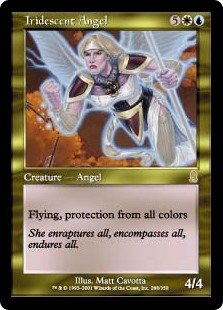I have always been a fan of protection as an ability. It’s been around since the game’s beginning, but it’s also arguably one of the most complicated abilities for players to comprehend – perhaps only beaten out by banding. This isn’t just a case of new players trying to understand more complex mechanics either; protection is something that even experienced players get tripped up from time to time. Namely because protection isn’t just one effect being granted – it’s actually four different ones rolled together.
Of the four major aspects (including damage prevention, unblockability, and untargetability), there have been plenty of games over the years where I’ve relied on granting protection to my creatures as a means of keeping them alive or ensuring that my attack was guaranteed to hit my opponent. In many ways, to me protection is the pinnacle utility for keeping creatures, well, protected. Indestructibility may keep them alive, but they can still be targeted. Having Hexproof or Shroud is nice but they still take damage.
The one inherent drawback, however, is that on most cards, protection is limited to a single color. While a series of card options developed over the years that allow you to specify which color you wish to protect from, thereby giving you the means to shift based on the obstacles you’re facing at any given time, the vast majority of protection is limited to a single color.
In time, some permanents began granting protection from two colors. A rare couple have even been granted three. Over the years we’ve also even seen one-off protections from lands, artifacts, and spells. But it wasn’t until the Alara block that the game literally gave us a card with Protection From Everything in the form of Progenitus. This five-color card, the culmination of all things protection-based, is a fearsome sight to behold for that trait alone. When you factor in that it’s gifted onto a 10/10 creature, it makes for a very large problem in a hurry.
Fortunately, Progenitus doesn’t see extensive EDH gameplay in most groups mostly because of its cost commitment. Unless trickery is used, it costs a whopping ten mana to cast it – not to mention the need to be running a five-color deck. Yet though those decks do exist, they aren’t nearly as common as decks of 1-3 colors.
That said, for protection fans there have been a pair of other creatures who predate the giant hydra god by several years, and while they made waves when they first debuted, their presence today in the dwindling days of protection favoritism is often overlooked.
So, naturally, we’re going to showcase one of them right now.
Today we have: Iridescent Angel

Name: Iridescent Angel
Edition: Odyssey / From The Vault: Angels
Rarity: Rare
Focus: Evasion
Highlights: Iridescent Angel was the first of its kind when it debuted in Odyssey, granting a creature protection from all five colors in Magic. This made it a 4/4 angel that couldn’t be targeted, blocked, or dealt damage – meaning that unless you were running board wipes or sacrifice cards, or otherwise kept it from ever hitting the board, you were in trouble.
Even at seven mana, that demigod-like trait was often deemed quite acceptable. Some may scoff a little in certain Commander spheres now, as it doesn’t look as imposing compared to the strength of many other creatures competing for attention nowadays, but its immunities are usually underestimated by opponents at their own detriment. For one, it’s essentially a guaranteed four damage a turn. For another, it exists in Blue / White, a color pair known for being able to protect its assets – should it even be necessary.
In time, Iridescent Angel was supplanted in the interests of many by Pristine Angel. Pristine seemingly had several things going for it over its sister: it had protection from artifacts in addition to colors, it’s one mana cheaper, it’s much easier to splash into decks with White, and it untaps itself whenever you cast spells. For decks that focused on tempo and efficiency, Pristine seemingly is better in all cases.
Except, perhaps ironically, in multiplayer settings like Commander.
Indeed, Iridescent Angel does have two major advantages over its sibling. First, Pristine’s protection is conditional only if it’s untapped, whereas Iridescent’s protection is ‘on’ at all times. This is helpful in games against multiple opponents where spells are a bigger commodity. Second, and more importantly, is that Iridescent can use equipment. Because it lacks protection from artifacts, Iridescent is fully capable of being loaded up with all manner of powerful equipment (or an Eldrazi Conscription for that matter), and being directed at any opponent you wish. Unless that player has an artifact creature – a flying one at that – then there’s little they can usually do. Don’t let it fool you: Iridescent Angle is capable of being an unblockable damage-dealing machine even by itself.
Likewise, it’s also fully useful as a defensive creature, as it can block with impunity, giving you a solid bolstering if need be.
Yes, Iridescent Angle is effectively Spectra Ward in creature form on both sides of the battlefield, but with the added bonus that it’s less susceptible to removal than an Aura.
Well, that, and it’s still much easier to cast than Progenitus…
Keep an eye out for us to be regularly featuring other more accessible-but-worth-it Commander cards going forward. In the meantime, we’ll keep the light on for you.
![]()
You can discuss this article over on our social media!
Do you have a particular Commander card to suggest for us to shine a future Spotlight on? You can send suggestions to ryan@cardboardrepublic.com
